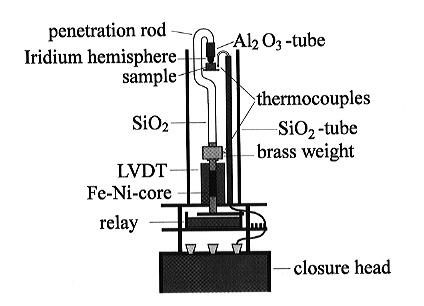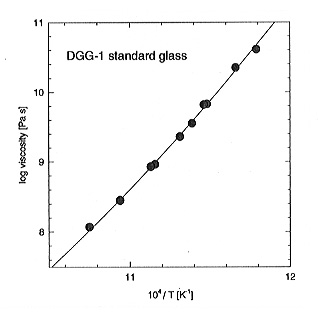

Viscosity plays an important role in the rheological behavior of silicate
melts. Thus, a better understanding of viscosity is required in order to
predict features of magma ascent or eruption. Because of the pressure dependence
of viscosity, high pressure viscosity data are needed for applications
to geological models. Here, we have developed a new dilatometer (see
Fig. 3.8-5) easily inserted into an internally heated pressure vessel
(IHPV) in order to study melt rheology. In particular, we are interested
in determining the viscosity of supercooled silicate melts at elevated
pressures.
 |
| Fig. 3.8-5: Cross-section of the apparatus. |
Our set-up uses the micropenetration method (for further details see
Annual Report 1996) and works most effectively in the viscosity range 108
<  < 1011 Pa s permitting
measurements at conditions that are relevant to the Earth´s crust
(P <= 10 kbar, T <=
1000° C). This new apparatus has now been
calibrated at 1 bar and runs successfully up to 2 kbar. It will be further
tested in order to extend the pressure range to 10 kbar. The advantages
of the micropenetration method are the ability to use small samples and
a simple sample geometry compared to other high viscosity
methods such as parallel plate or fiber elongation. The use of small samples
minimizes thermal gradients across the sample.
< 1011 Pa s permitting
measurements at conditions that are relevant to the Earth´s crust
(P <= 10 kbar, T <=
1000° C). This new apparatus has now been
calibrated at 1 bar and runs successfully up to 2 kbar. It will be further
tested in order to extend the pressure range to 10 kbar. The advantages
of the micropenetration method are the ability to use small samples and
a simple sample geometry compared to other high viscosity
methods such as parallel plate or fiber elongation. The use of small samples
minimizes thermal gradients across the sample.
For calibration, we measured the viscosity of the DGG-1 standard glass
from the "Deutsche Glastechnische Gesellschaft". All cylindrical samples
were polished (3 mm in height, 4 mm in radius), heated at a rate of 10
K/min and equilibrated at the measuring conditions for 1 hour to ensure
complete structural relaxation (Fig. 3.8-6).
 |
|
This dilatometer has now been precisely calibrated for room-pressure measurements. In the range of 108 - 1011 Pa s the deviation is low and nearly constant. The viscosity data have been reproduced within an error of ± 0.06 log units. In several high-pressure experiments this set-up has run successfully up to 2 kbar. Our current aim is to carry out measurements up to 10 kbar. Further investigations are required to construct a complete calibration curve that will enable viscosity determinations of volatile bearing silicate melts under geologically relevant conditions to be made.

Tel: +49-(0) 921 55 3700 / 3766, Fax: +49-(0) 921 55 3769, E-mail: bayerisches.geoinstitut(at)uni-bayreuth.de
 Previous page
Previous page